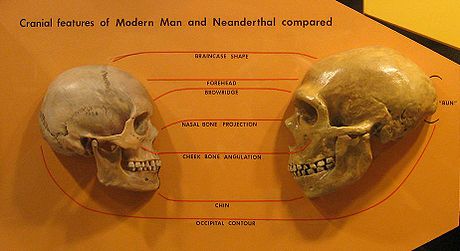- Archaic Homo sapiens
-
"Dawn men" redirects here. For the stone circle, see Dawn's Men.
 Homo rhodesiensis "Broken Hill Cranium": dated to either 130,000 years ago (using amino acid racemization determination) or 800,000 to 600,000 years ago (within the same time as Homo erectus), depending on which dating method is used.
Homo rhodesiensis "Broken Hill Cranium": dated to either 130,000 years ago (using amino acid racemization determination) or 800,000 to 600,000 years ago (within the same time as Homo erectus), depending on which dating method is used.
Archaic Homo sapiens is a loosely defined term used to describe a number of varieties of Homo, as opposed to anatomically modern humans (Homo sapiens sapiens), in the period beginning 500,000 years ago. The term is typically taken to include Homo heidelbergensis, Homo rhodesiensis, Homo neanderthalensis and sometimes Homo antecessor.[1]
Modern humans are believed to have evolved from archaic Homo sapiens, who in turn evolved from Homo erectus. Varieties of archaic Homo sapiens (also "Archaics" for short[dubious ]) are included under the binomial name "Homo sapiens" because their brain size is very similar to that of modern humans. Archaic Homo sapiens had a brain size averaging 1200 to 1400 cubic centimeters, which overlaps with the range of modern humans. Archaics are distinguished from anatomically modern humans by having a thick skull, prominent brow ridges and the lack of a prominent chin.[1][2]
Anatomically modern humans appear from about 200,000 years ago and after 70,000 years ago (see Toba catastrophe theory) gradually marginalize the "archaic" varieties. Non-modern varieties of Homo are certain to have survived until after 30,000 years ago, and perhaps until as recent as 10,000 years ago. Which of these, if any, are included under the term "archaic Homo sapiens" is a matter of definition and varies among authors.
Contents
Terminology and definition
The category archaic Homo sapiens is disputed[1] and lacks a single, agreed upon definition. According to one definition, Homo sapiens is a single species comprising several subspecies that include the archaics and modern humans. Under this definition, modern humans are referred to as Homo sapiens sapiens and Archaics are also designated with the prefix "Homo sapiens". For example, the Neanderthals are Homo sapiens neanderthalensis, and Homo heidelbergensis is Homo sapiens heidelbergensis. Other taxonomists prefer not to consider archaics and modern humans as a single species but as several different species. In this case the standard taxonomy is used, ie Homo rhodesiensis, or Homo neanderthalensis.[1]
The dividing lines that separate modern humans from archaic Homo sapiens and archaics from Homo erectus are blurry. The earliest known fossils of anatomically modern humans such as the Omo remains from 195,000 years ago, Homo sapiens idaltu from 160,000 years ago, and Qafzeh remains from 90,000 years ago are recognizably modern humans. However, these early modern humans do exhibit a mix of some archaic traits, such as moderate, but not prominent, brow ridges.
Brain size expansion
The emergence of Archaic Homo sapiens is sometimes used as an example of punctuated equilibrium.[3] This occurs when a species undergoes significant biological evolution within a relatively short period. Subsequently, the species undergoes very little change for long periods until the next punctuation. The brain size of Archaic Homo sapiens expanded significantly from 900 cubic centimeters in erectus to 1300 cubic centimeters. Since the emergence of archaics, brain size has remained stable up until the present.
Origin of language
Main article: Origin of languageRobin Dunbar has argued that Archaic Homo sapiens were the first to use language. Based on his analysis of the relationship between brain size and hominid group size, he concluded that because Archaic Homo sapiens had large brains, they must have lived in groups of over 120 individuals. Dunbar argues that it was not possible for Hominids to live in such large groups without using language, otherwise there could be no group cohesion and the group would disintegrate. By comparison, chimpanzees live in smaller groups of up to 50 individuals.[4][5]
Fossils
Further information: List of human evolution fossils- Sima de los Huesos
- Saldanha Man
- Altamura Man
- Kabwe Skull
- Steinheim Skull
See also
- Human
- Human evolution
- Evolution of human intelligence
- Homo sapiens idaltu
- Homo erectus
- Recent African Origin
- Early human migrations
- Middle Paleolithic
- Neanderthal extinction hypotheses
References
- ^ a b c d Dawkins (2005). "Archaic homo sapiens". The Ancestor's Tale. Boston: Mariner. ISBN 061861916X. http://books.google.com/books?id=rR9XPnaqvCMC&printsec=frontcover#PPA62,M1.
- ^ Companion encyclopedia of archaeology
- ^ Alone in the Universe
- ^ CO-EVOLUTION OF NEOCORTEX SIZE, GROUP SIZE AND LANGUAGE IN HUMANS
- ^ Dunbar (1993). Grooming, Gossip, and the Evolution of Language. Harvard University Press. ISBN 9780674363366. http://books.google.com/?id=nN5DFNT-6ToC&printsec=frontcover#PPA112,M1.
External links
- EARLY AND LATE “ARCHAIC“HOMO SAPIENS AND “ANATOMICALLY MODERN” HOMO SAPIENS
- Origins of Modern Humans: Multiregional or Out of Africa?
- Homo sapiens, Museum of Natural History
Part of the series on Human evolution Humans and Proto-humansHomo: H. gautengensis · H. habilis · H. rudolfensis · H. georgicus · H. ergaster · H. erectus (H. e. erectus · H. e. lantianensis · H. e. palaeojavanicus · H. e. pekinensis · H. e. nankinensis · H. e. wushanensis · H. e. yuanmouensis · H. e. soloensis) · H. cepranensis · H. antecessor · H. heidelbergensis · Denisova hominin · H. neanderthalensis · H. rhodesiensis · H. floresiensis · Archaic Homo sapiens · Anatomically modern humans (H. s. idaltu · H. s. sapiens)Categories:- Recent single origin hypothesis
- Human evolution
- Humans
- Middle Stone Age
- Paleoanthropology
- Early species of Homo
Wikimedia Foundation. 2010.

